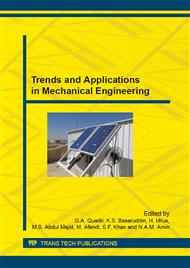[1]
G.P. Pucillo, M. Grasso, F. Penta, P. Pinto, On the mechanical characterization of materials by Arcan-type specimens, Engng. Fract. Mech. 78 (2011), 1729-1741.
DOI: 10.1016/j.engfracmech.2011.02.002
Google Scholar
[2]
A. Pirondi, G. Nicoletto, Mixed Mode I/II fracture toughness of bonded joints, Int. J. Adhes. Adhes. 22 (2002), 109-117.
DOI: 10.1016/s0143-7496(01)00042-2
Google Scholar
[3]
Z. Liu, R.F. Gibson, G.M. Newaz, The use of a modified mixed mode bending test for characterization of mixed-mode fracture behavior of adhesively bonded metal joints, J. Adhes. 78 (2002), 223-244.
DOI: 10.1080/00218460210408
Google Scholar
[4]
F. Ducept, P. Davies, D. Gamby, Mixed mode failure criteria for a glass/epoxy composite and an adhesively bonded composite/composite joint, Int. J. Adhes. Adhes. 20 (2000), 233-244.
DOI: 10.1016/s0143-7496(99)00048-2
Google Scholar
[5]
M. Arcan, Z. Hashin, A. Voloshin, A method to produce plane-stress states with applications to fiber-reinforced materials, Exp. Mech. 18 (1978), 141-146.
DOI: 10.1007/bf02324146
Google Scholar
[6]
L. Banks-Sills, M. Arcan, A compact mode II fracture specimen, fracture mechnics, ASTM STP 905 17 (1986), 347-363.
DOI: 10.1520/stp17406s
Google Scholar
[7]
M.A. Sutton, M.L. Boone, F. Ma, J.D. Helm, A combined modeling-experimental study of the crack opening displacement fracture criterion for characterization of stable crack growth under mixed mode I/II loading in thin sheet materials, Engng. Fract. Mech. 66 (2000).
DOI: 10.1016/s0013-7944(00)00011-4
Google Scholar
[8]
M.A. Sutton, X. Deng, F. Ma, J.C.J. Newman, M. James, Development and application of a crack tip opening displacement-based mixed mode fracture criterion, Int. J. Solids Struct. 37(2000), 3591-3618.
DOI: 10.1016/s0020-7683(99)00055-4
Google Scholar
[9]
H.L.J. Pang, C.W. Seetoh, A compact mixed mode (CMM) fracture specimen for adhesive bonded joints, Engng. Fract. Mech. 57 (1997), 57-65.
DOI: 10.1016/s0013-7944(97)00014-3
Google Scholar
[10]
H.L.J. Pang, Mixed mode fracture analysis and toughness of adhesive joints, Engng. Fract. Mech. 51 (1995), 575-583.
DOI: 10.1016/0013-7944(94)00310-e
Google Scholar
[11]
N. Choupani, Interfacial mixed-mode fracture characterization of adhesively bonded joints, Int. J Adhes. Adhes. 28 (2008), 267-282.
DOI: 10.1016/j.ijadhadh.2007.08.002
Google Scholar
[12]
N. Choupani, Mixed mode cohesive fracture of adhesive joint: Experimental and numerical studies, Engng. Fract. Mech. 75 (2008), 4363-4364.
DOI: 10.1016/j.engfracmech.2008.04.023
Google Scholar


